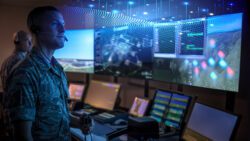Charles River Analytics Inc., developer of intelligent systems solutions, demonstrated its MINOTAUR soldier-machine interface at the Marine Corps Warfighting Laboratory’s 2016 Intuitive Robotic Operator Control of Autonomous Behaviors (IROC-A) Challenge. The event was held from October 24-28, 2016, at the Muscatatuck Urban Training Center in Butlerville, Indiana.
MINOTAUR is an intuitive interface for controlling robotic leader-follower systems in small team operations. It fuses multiple, proven leader-tracking and robot control technologies to provide a reliable, hands-free interface for Warfighters teaming with autonomous systems in challenging environments. With MINOTAUR, operators can use voice and hand signals to send messages to a robot.
“The event consisted of challenges designed to evaluate intuitive robot control technologies and autonomous behaviors,” said Camille Monnier, Senior Scientist at Charles River. “We demonstrated advanced autonomous behaviors and human-robot interface technologies in MINOTAUR, including leader-following and speech and gesture recognition, as well as autonomous exploration and self-localization and mapping.”

The MINOTAUR system’s view of the world
MINOTAUR can help robots communicate with, and relay directions to other squads or assets. The robot can become a true support agent as part of a human-robot team, requiring direct teleoperation only to execute specific tasks that need the most human skill, such as disarming or detonating an improvised explosive device (IED). Through natural and reliable control, MINOTAUR-enabled UGV robots will reduce the cognitive burden on Warfighters in the field, increase trust in human-robot teams, and remove Warfighters from harm’s way, thus accelerating the adoption of these mule-like UGV systems.
Learn more about our projects and capabilities in Unmanned Systems.
This material is based upon work supported by the US Army under Contract No. W56HZV-15-C-0110. Any opinions, findings and conclusions or recommendations expressed in this material are those of the author(s) and do not necessarily reflect the views of the US Army.




